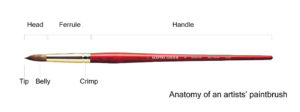A paintbrush is an artists’ wand creating magic on a canvas. Whether you are a budding painter or one with years of experience, your paintbrush will be your prime tool to greatness.
While different media require different brushes the sheer variety and choice is nerve-racking and although making the right choice may seem daunting at first, a little knowledge in basics will give you just the jump start you need. Maybe you’ve just picked up a paintbrush for the first time, maybe you’ve never attended a single art class in your life and if that is you, these tips are especially made to guide you through the basics.
An artists’ brush has three main parts.
- Head
- Ferrule
- Handle
The characteristics of a brush a determined by the head and the handle.
Head- Types of Hair/Bristle. This could be natural, synthetic or a mix. Also the Shape and size come in many variations.
Handle– Long or short
An artist has to answer two vital questions before investing on brushes.
- What surface do you want to paint on?
- What colour material do you want to use?
Depending on above two factors your brush selection varies with the head material and handle type.
Head Type
Although head has variations in shape and size, which will be addressed in the next article, your key factor for selecting the right brush attributes to the material the head is made of. There are natural, synthetic and mixed heads we need to be familiar with.
Natural
These heads are made of either hair or bristles.
Natural hair used for brushes is generally obtained from hair of the Sable, an animal belongs to the family of weasels and badgers. Known for smooth strokes and its subtle ability to blend, a brush made of Sable hair is associated with water colour paintings for its superior water absorbent qualities and the gentleness on paper. These qualities enables artists to add life to intricate work and flush fills.
A natural hair brush although more expensive than its synthetic counterparts, gives flexibility and strength. Experienced artists swear by the natural hairs of a sable, and it is believed that the finest sable hair comes from the Kolinsky, an animal found in the colder regions of Russia and China. This kind of brush possesses the ability to hold the most paint in a single dip and is the ultimate brush that is used as the benchmark to measure the performance of water colour brushes.

Winsor & Newton Kolinsky Series 7 Sable Brushes are regarded as the world’s finest.
Bristles on the other hand are stiffer, courser and at the same time have a good spring action to help hard applications and to retain the original shape owing to the bristle’s natural curvy shape. With these properties bristle are meant for more viscous colours such as Oil and Acrylic also able to withstand rough textured surfaces like canvas. A natural bristle carry a split end called the “flag” that holds more colour. There are low cost brushes in the market that uses cut bristles, compromising the benefits of the curve and flag so be mindful in selecting a quality bristle brush.
Synthetic
While natural hair brushes provide reliability and quality, they are expensive to produce. Today, synthetic materials are also of advanced quality and engineered in such a way to mimic natural hair to a great degree. Polyester fibers used for this purpose are better known by the commercial name “Taklon”. They are more resistant to chemical solvents and colours making a synthetic haired brush the ultimate match for acrylic colour. Acrylic colours have a high pH value that is said to corrode natural hairs over time.
Golden haired Taklon is ideal for water colour due to its sable like properties.
A beginner artist might not have the ability to flaunt an expensive natural haired brush. Specially if you are still discovering what medium to progress with, there are plenty of student grade brushes with decent colour handling capabilities that will allow you to practice and draw to your heart’s content. They are versatility enough in handling water colour, acrylic and even on oil to ease the burden on a heavy investment on an array of different brushes. Winsor & Newton University Brush series offer good quality mix medium brushes for you to try out if you are beginning to paint.
Mixed Hair
Built taking affordability and quality into consideration is where a mixed haired brush comes into play. The perfect combination of both natural and synthetic hair, these brushes provide colour absorbance, spring and point while keeping costs at a middle ground. An example of an illustrative mixed haired brush for water colour that you can test the waters with is Winsor & Newton Sceptre Gold.
Handle
The key variable factor here is the length. Brushes come with either short or long handles.
A Short handle allows you more control when attempting those intricate details that require subtle touches with water colour on paper where you work on a flat surface, while a long handle on the other hand is ideal when working with oil and acrylic containing harsh chemical fumes that should not be closely inhaled. Since the canvas/paper is often mounted upright on a canvas, long handles are perfectly at arms’ reach so to allow you work at a reasonable distance from your paint.
As you grow and explore your journey of colour, don’t forget to enjoy the process, to really throw yourself into your art and create vibrancy and originality. The journey only gets better with time and each brush stroke. Begin with a brush that will help you bring out your passion. There is world of paintbrushes to suit every colour material and every surface, novice or veteran.













